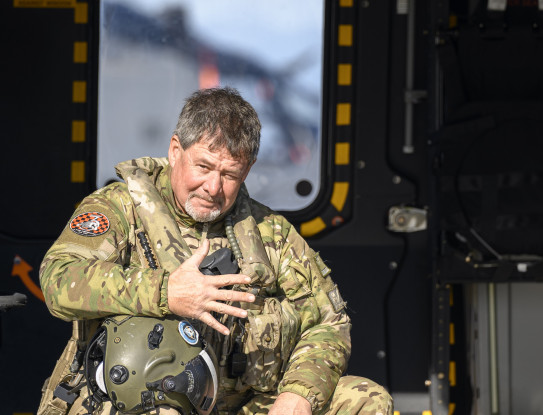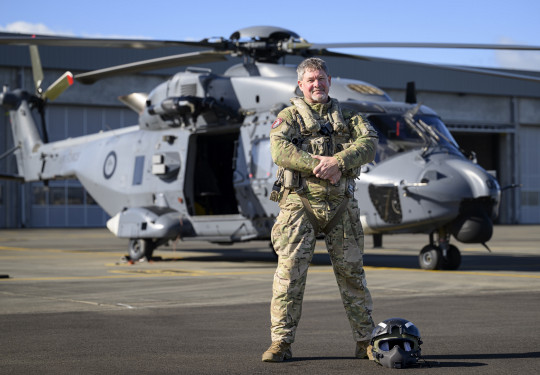RNZAF loadmaster logs 5000 hours of ‘best office view in the world’
A Royal New Zealand Air Force (RNZAF) helicopter loadmaster has clocked up the rare milestone of 5000 flying hours.
23 July, 2025
Flight Sergeant Andrew “Sparrow” Gaskin, from RNZAF Base Ohakea’s No.3 Squadron, learned of the feat recently when one of his crew reached over with a huge smile and shook his hand during a flight.
“I suddenly realised why I was being congratulated. It was a great moment, and it felt great sharing it with my team,” he said.
Flight Sergeant Gaskin, originally from Christchurch, has spent 30 years in the RNZAF, working with the Iroquois helicopter and more recently the NH90 medium utility helicopter.
No.3 Squadron calculated that with the helicopters’ speeds and flight hours (which totalled more than 200 days), Flight Sergeant Gaskin could have travelled to the moon and back one and a half times.
“My office has the best view in the world, and I have loved my career,” he said.
During his career, Flight Sergeant Gaskin has travelled to Antarctica, East Timor, Bougainville, Australia, Fiji, Samoa, United Kingdom, Cyprus, Belgium, Germany, Kosovo and Bosnia.
“I’d have to say that Antarctica was the best place that I have flown in. When you get off the Hercules on the ice runway, it’s like setting foot on a different planet.
“I was lucky enough to do two tours on the ice and flew in our ‘Hueys’ up on to the polar plateau to a place called meteorite city, through the Dry Valleys and all over Ross Island including landing on the sea ice.
“I also flew over the top of Mount Erebus and peered down into its crater. It is an amazing place and quite different to any other location that I have flown in.”
Flight Sergeant Gaskin has also contributed to peacekeeping in Bougainville and East Timor and provided emergency assistance after Cyclone Gabrielle and the Whakaari/White Island eruption. However, the most rewarding jobs for him remain those where the crew are working to save someone’s life.
“The loadmaster is the first person to interact with people who have been rescued. It’s a special moment and I’ve been lucky enough to be part of that for quite a few people rescued from the bush and off the tops of mountains.”
I suddenly realised why I was being congratulated. It was a great moment, and it felt great sharing it with my team.
Flight Sergeant Andrew “Sparrow” Gaskin

Flight Sergeant Gaskin said the RNZAF’s NH90 was a vastly different helicopter from the Huey – the Bell UH-1H Iroquois - which was a very basic helicopter. The Huey did not have an autopilot and had to be actively flown by pilots.
“The Huey had a tendency to bite back if it was pushed past its limits and so a good ‘hands and feet’ pilot was needed. They had to be very aware of the environmental conditions, especially the wind direction.
“The Huey did not need as much technical support as an NH90 and we often took it away on tasks overnight and the aircrew could do all the maintenance themselves.”
The NH90 was a very capable all-weather machine that could fly in icing conditions whereas the Huey could not, he said.
“For an NH90 you need a computer or iPad for flight planning and these tools give your situational awareness a huge boost, way beyond what was available to Huey crews.”
Flight Sergeant Gaskin was thankful to all the crew who had trained him over the years.
“All the pilots that trusted my directions and judgement, all the engineers, maintenance and support trade personnel that allow the team at No. 3 Squadron to keep operating.
“Finally, I’d like to thank the current team for continuing to put up with this old crew dog.”
